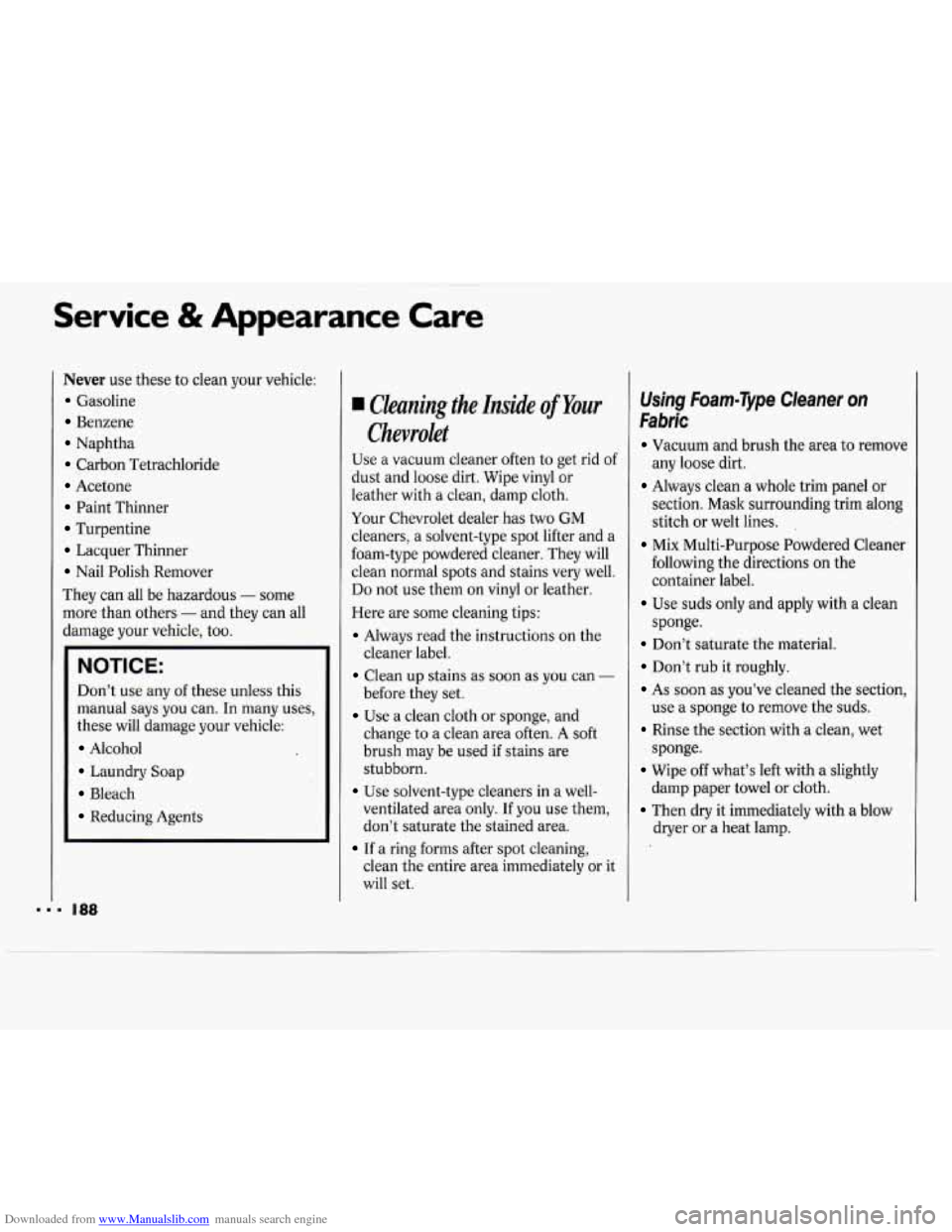Page 158 of 243
Downloaded from www.Manualslib.com manuals search engine I
While refueling, hang the cap inside the
fuel door. Be
careful not. to spill gasohe: Clean
gasoline from painted surfaces as soon
as possible. See Cleaning the Outside
of Your Chevrolet in the Index.
When you put the cap back on, turn it
to the right until you hear at least three
clicks.
NOTICE:
If you need a new cap, be sure to
get the right type. Your dealer can
get one for you.
If you get the
wrong type, it may not fit or have
proper venting, and your fuel tank
and emissions system might be
damaged.
Checking ntings Under the
Hood
The following sections tell you how to
check fluids, lubricants and important
parts underhood.
Page 189 of 243

Downloaded from www.Manualslib.com manuals search engine Service & Appearance Care
Never use these to clean your vehicle:
Gasoline
Benzene
Naphtha
Carbon Tetrachloride
Acetone
Paint Thinner
Turpentine
Lacquer Thinner
Nail Polish Remover
They can all be hazardous
- some
more than others
- and they can all
damage your vehicle, too.
NOTICE:
Don’t use any of these unless this
manual says
you can. In many uses,
these will damage your vehicle:
Alcohol
Laundry Soap
Bleach
Reducing Agents
Cleaning the Inside of Your
Chevrolet
Use a vacuum cleaner often to get rid of
dust and loose dirt. Wipe vinyl or
leather with
a clean, damp cloth.
Your Chevrolet dealer has two GM
cleaners, a solvent-type spot lifter and a
foam-type powdered cleaner. They will
clean normal spots and stains very well.
Do not use them on vinyl or leather.
Here are some cleaning tips:
Always read the instructions on the
cleaner label.
Clean up stains as soon as you can -
before they set.
Use a clean cloth or sponge, and
change to a clean area often.
A soft
brush may be used
if stains are
stubborn.
ventilated area only. If you use them,
don’t saturate the stained area.
If a ring forms after spot cleaning,
clean the entire area immediately or it
will set.
Use solvent-type cleaners in a well-
Using Foam-Type Cleaner on
Fabric
Vacuum and brush the area to remove
Always clean a whole trim panel or
any
loose dirt.
section. Mask surrounding trim along
stitch or welt lines.
,
Mix Multi-Purpose Powdered Cleaner
following the directions on the
container label.
Use suds only and apply with a clean
Don’t saturate the material.
Don’t rub it roughly.
As soon as you’ve cleaned the section,
use a sponge to remove the suds.
Rinse the section with a clean, wet
sponge.
Wipe off what’s left with a slightly
damp paper towel or cloth.
Then dry it immediately with a blow
dryer or a heat lamp.
sponge.
Page 212 of 243

Downloaded from www.Manualslib.com manuals search engine 6, Transaxle Service - For manual
transaxles, fluid doesn’t require
changing. See
Periodic Maintenance
Inspections
in the Index. For
automatic transaxles, change both
the fluid and filter every 15,000 miles
(25
000 km) if the vehicle is mainly
driven under one or more of these
conditions:
In heavy city traffic where the outside
temperature regularly reaches 90°F
(32°C) or higher.
In hilly or mountainous terrain.
Uses such as found in taxi, police car
If you do not use your vehicle under
any of these conditions, change both
the fluid and filter every 100,000 miles
(166
000 lun).
7. Spark Plug Replacement (Except
2.2L Code
4 engine)* - Replace
spark plugs with the proper type. See
Replacement Parts in the Index.
or delivery service.
8. Spark Plug Replacement (P.2L
Code 4 engine only)* - Replace
spark plugs with the proper type.
See
Replacement Parts in the
Index.
9. Spark Plug Wire Inspection*t -
Inspect for burns, cracks or other
damage. Check the boot
fit at the
coils and at the spark plugs. Replace
wires as needed.
IO. Exhaust Gas Recirculation (EGR)
System Inspection (2.2L Code
4
engine only)*? - Conduct the
EGR system service as described
in
the service manual. To purchase a
service manual, see
Service
Publications
in the Index.
1 1. Air Cleaner Filter Replacement*‘
- Replace every 30,000 miles
(50
000 km) or more often under
dusty conditions. Ask your dealer
for the proper replacement intervals
for your driving conditions.
12. Fuel Tank, Cap and Lines
Inspection’#t
- Inspect fuel tank,
cap and lines (including fuel rails
and injection assembly) for damage
or leaks. Inspect fuel cap gasket for an even filler neck imprint or any
damage. Replace parts as needed.
Periodic replacement of the fuel
filter is not required.
NOTE: To determine your engine’s
displacement and code, see
Engine
Identification
in the Index.
* = An Emission Control Service.
t = The U.S. Environmental Protection Agency
or the California Air Resources Board has
determined that the failure to perform this
maintenance item will not nullify the
emission warranty
or limit recall liability
prior to the completion of vehicle useful life.
General Motors, however, urges that all
recommended maintenance services be
performed at the indicated intervals and the
maintenance be recorded in “Section
E:
Maintenance Record.”